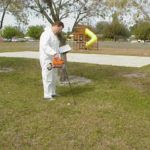One type of environmental monitoring is soil testing. This sounds simple enough, but exactly what is soil testing? Well, let’s break apart the term.
First, soil is the upper part of the earth’s crust in which plants can sometimes grow. It may be sandy, loamy, clayey, rocky, shelly, or peat-like. Sometimes, it is referred to as dirt. It is what we walk on when we go outside where there is no pavement, decking, pavers, concrete, etcetera.
Second, testing takes many forms. It can be done with the unaided eye, electronic meters after mixing with water, organic vapor analyzers, or laboratory analysis. Testing done on the soil samples in the field is called in situ testing.
Samples can be collected manually or with powered equipment. Manually collected samples can be collected with spoons, augers, or dredges which are then transferred into bottles in the field for in situ testing or into laboratory sample bottles for analysis at the laboratory.
Powered equipment typically includes split spoon samplers or direct push rigs which collect the soil samples from desired depths. The soil is then transferred into the field bottles or laboratory sample bottles. The samples are then either analyzed in the field or at the laboratory.
Whether the samples are collected manually or with powered equipment, generally, they are ultimately analyzed in a laboratory. They can be analyzed for biological, chemical, or physical parameters. In Florida, the laboratory should or must be accredited by the National Environmental Laboratory Accreditation Program, NELAP (www.nelac-institute.org) and be certified by the Florida Department of Health (www.floridahealth.gov). The data will not be accepted by regulatory agencies unless it is generated from one of these laboratories.
Why would you want to test the soil? There are lots of reasons. One is that you want to be proactive because you truly care or for public relations. For example, you may want to produce soil data that show your facility is not polluting the soil below or adjacent to your facility. This could be related to the use or storage and handling of solvents, gasoline, diesel fuel, oil, pesticides, heavy metals, dry cleaning fluids, or many other chemicals. Another reason may be for a soil remediation project, or to meet monitoring requirements under an existing Remedial Action Plan. Additionally, you may have had a spill, discharge, or leak and you are being required or you are volunteering to test the soil for contamination. In that case, you may need to determine if you have impacted the soil or if you have cleaned it up. Finally, you may be planning to introduce a new operation and need to establish current soil conditions so that the operation’s impact can be projected. After the operation is up and running, more testing can be done to determine if your projections were accurate.
If you do end up testing the soil, you will want to make sure that it is done properly and that the data are valid and court defensible. Otherwise, you may end up with credibility problems. Adverse publicity or scrutiny from the media and environmental watchdog groups is not worth it. Even if you truly have no impact on the quality of the soil, it may be perceived that you do because of faulty data.
This is where Environmental Safety Consultants (www.escflorida.com) can help. We have the credentials and experience to properly complete your soil environmental monitoring. We are a Florida-licensed Engineering business with environmental scientists, a Professional Engineer (P.E.), and years of experience testing soil for contamination. We are just a telephone call (800-226-1735) or an e-mail away (escinc@verizon.net). Contact us today!
